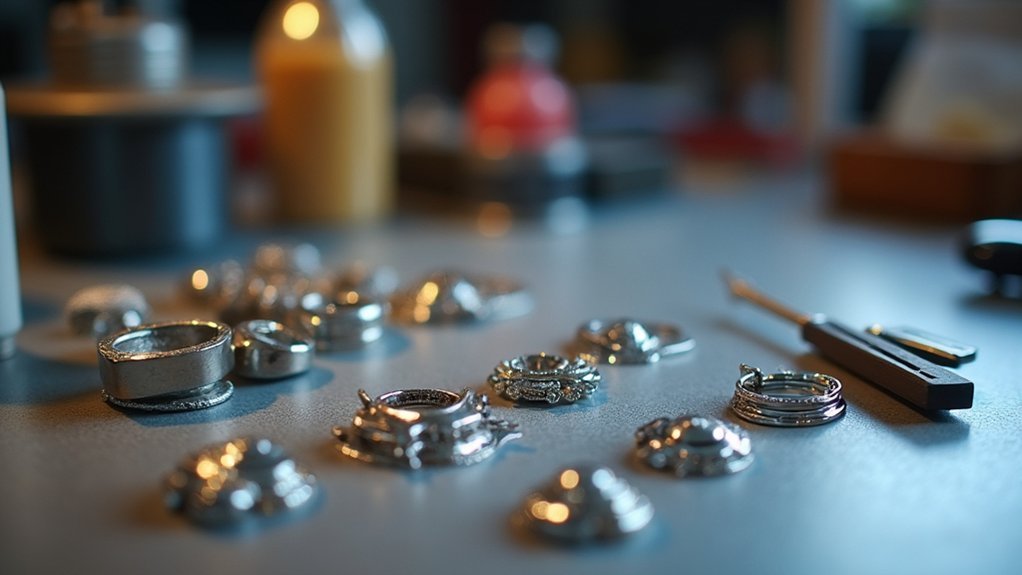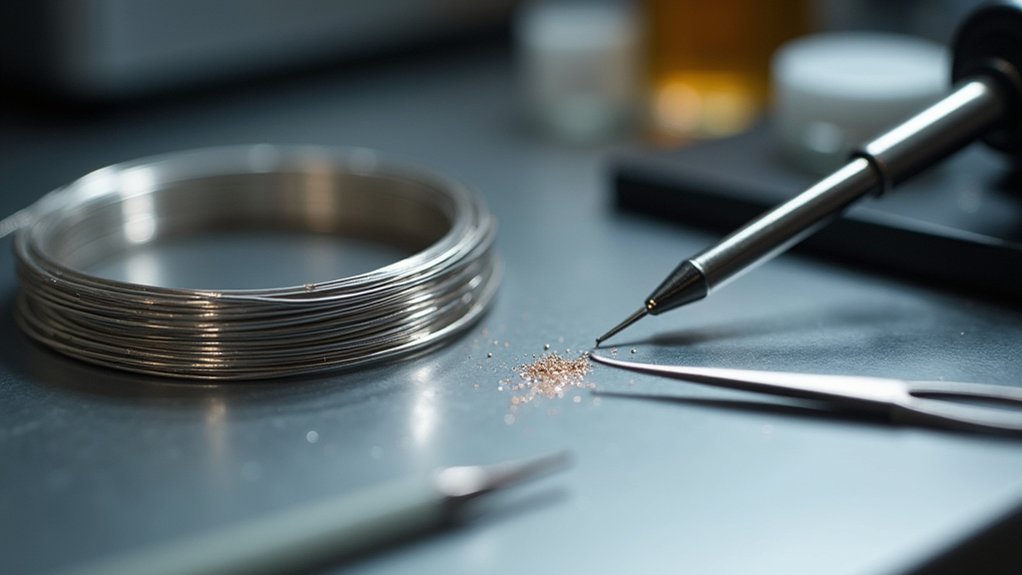You’ll master platinum soldering by focusing on three key techniques. First, use specialized carbide and tungsten tools stored separately to prevent contamination from other metals. Second, maintain precise temperature control between 1500-1700°C using propane or natural gas for clean results. Third, prepare your joint surfaces meticulously by removing all oils and dirt, then create V-shaped grooves for ideal fitting. These fundamentals will transform your platinum work into professional-quality pieces with seamless joints.
Essential Tools and Safety Equipment for Platinum Soldering

Five specialized tools form the foundation of any successful platinum soldering setup.
You’ll need carbide and tungsten tools that provide the durability and precision necessary for working with this soft metal. A high-temperature soldering block from manufacturers like Wesgo or Rio Grande manages heat effectively without contaminating your platinum.
Safety glasses specifically designed for platinum soldering protect your eyes from bright flames while improving visibility during high-temperature work.
You must maintain a separate set of tools exclusively for platinum to prevent contamination from steel implements that introduce unwanted elements. An oxy-hydrogen torch delivers cleaner burns than acetylene, avoiding contaminants during the soldering process.
Don’t forget proper flux when soldering platinum, as it guarantees ideal flow and joint quality throughout your project.
Temperature Control and Gas Selection Techniques
When working with platinum, you’ll achieve ideal results by maintaining precise temperature control between 1500°C for head-to-shank assemblies and up to 1700°C for sizing operations.
Your gas selection directly impacts results—choose propane or natural gas over acetylene, which can contaminate the platinum with harmful impurities. You don’t need preheating with platinum soldering, so you can apply solder immediately once joints are prepared.
Choose propane or natural gas over acetylene to prevent platinum contamination—no preheating required for immediate solder application.
Maintain a clean work environment to prevent carbon contamination from improper heat control.
Use thin solder pieces for better precision and cleaner appearance, especially in hard to reach areas where thick pieces create messy joints.
Monitor your melting temperature carefully, as different platinum alloys require precise control for successful bonds.
Proper Joint Preparation and Solder Application Methods

Three critical steps form the foundation of successful platinum soldering: meticulous surface preparation, precise joint fitting, and controlled solder application. Before starting your platinum work, you’ll need proper joint preparation by removing oils, dirt, and polish from both surfaces, as contamination creates weak joints.
Create a V-shaped groove when fitting pieces together. This technique enables seamless welding and provides better control during solder application. Use thin solder pieces for precision – they’ll help you achieve a clean joint without excess material.
| Preparation Step | Best Practice |
|---|---|
| Surface Cleaning | Remove all oils and contamination |
| Joint Design | Create V-shaped groove for fit |
| Solder Size | Use thin pieces for control |
| Heating Method | Heat both components evenly |
| Gap Management | Maintain close spacing of joints |
Always heat both components evenly before applying solder, and maintain close spacing of joints for ideal results.
Frequently Asked Questions
Do You Use Flux When Soldering Platinum?
You shouldn’t use flux when soldering platinum since it’ll contaminate and weaken your joints. You’ll only need flux when you’re combining platinum with gold alloys to help hold solder.
What Is the Easiest Solder for Beginners?
You’ll find high-temperature seamless solder most forgiving since it melts at 1700°C and prevents brittleness. Choose thin pieces for precise control, or consider 18K white cadmium-free solder for heat-sensitive work.
What Temperature Do You Solder Platinum At?
You’ll solder platinum at different temperatures depending on your project: 1500°C for head-to-shank assemblies, 1200°C for earring posts, and 1700°C for sizing applications with proper gas-oxygen torches.
Is Platinum Difficult to Work With?
You’ll find platinum challenging because it’s softer than other metals, has poor heat conductivity, and requires precise techniques. It’s less forgiving, demands specialized tools, and needs meticulous cleanliness to avoid contamination issues.
In Summary
You’ll master platinum soldering faster by focusing on these three fundamentals. Don’t skip investing in quality safety gear and the right torch setup—it’s worth every penny. Remember, temperature control separates beginners from pros, so practice your flame adjustment until it’s second nature. Most importantly, you can’t rush joint preparation; clean, properly fitted pieces with correctly applied solder will give you professional results every time. Keep practicing these basics consistently.





Leave a Reply